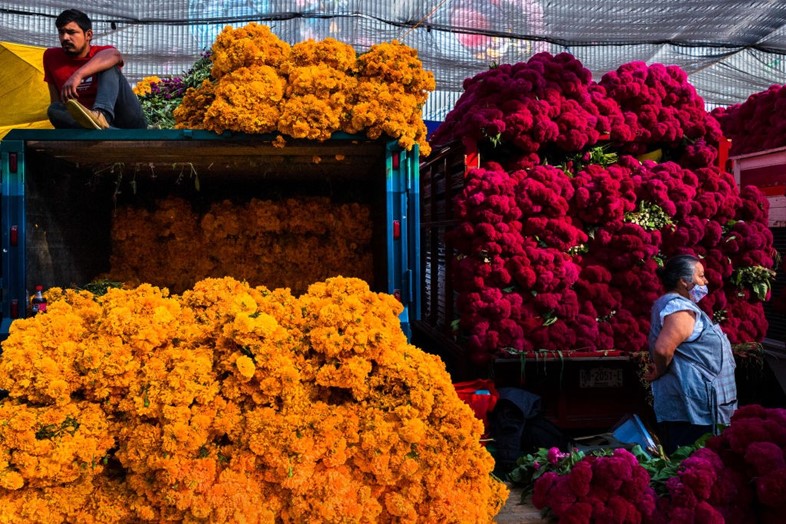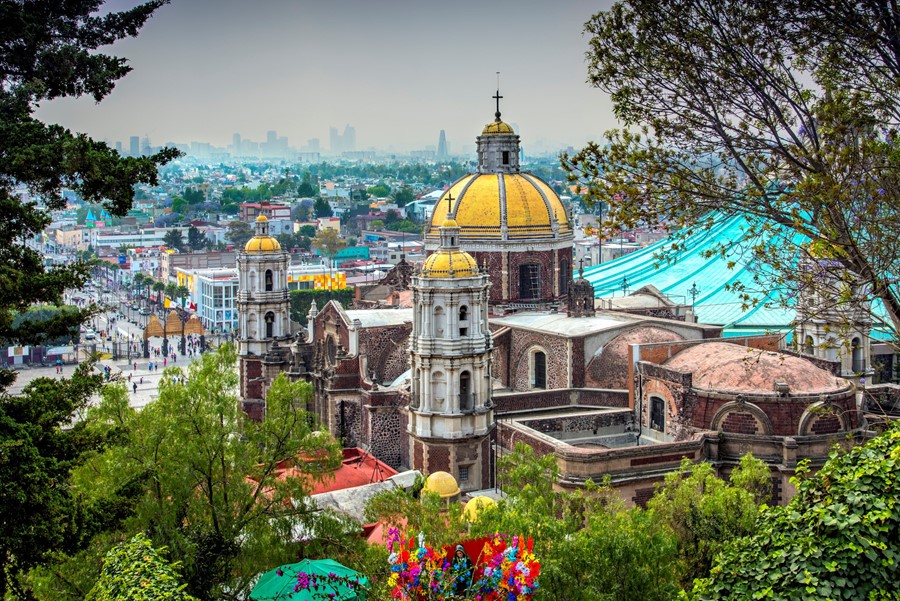Darcie Imbert offers a guide to the city’s food, art and culture that aims to be a starting point supplemented by spontaneity
Just when you think you’ve seen the best of Mexico City, someone will take you to their neighborhood taqueria with no name, identifiable only by the long queue snaking down the street. As more people discover what the city has to offer, the line for Rosetta gets longer, tables at Contramar become increasingly unobtainable, and miscellaneous objects at Las Lagunilla get more expensive. But the Mexican designer Fernando Laposse explained that Mexico City has two self-releasing pressure valves that slow down the throes of tourism and gentrification: precarious safety and earthquakes, which ironically helps to preserve its true nature.
Wait in line for the guava pastry at Rosetta or tuna tostadas at Contramar, but don’t stop there. The best way to experience CDMX is to talk to people and experience their version of the city; not the one that’s created through a Western lens. With that in mind, consider this guide a starting point to be supplemented by spontaneity.
Luis Barragán
An icon, a legend, a master of modernism (to some); no trip to Mexico City is truly complete without a jaunt into the world of Barragán. There are the better known domestic sanctuaries – Casa Estudio Luis Barragán, Casa Ortega, Casa Gilardi, and Cuadra San Cristóbal. Then there are the lesser visited locations, such as the ethereal Capuchin Convent Chapel with its monolithic altar, yellow-stained glass window and orange walls, which feels like bathing in liquid gold. The chapel is run by nuns who tend to the legacy of two idols, making all kinds of monastic goods to take home. All of these works sit on the emotional side of the Barragán spectrum; at the other end sits his functional work. Melchor Ocampo 38 possesses a more prosaic kind of beauty, it was originally designed by Barragán with Max Cetto as a series of artists apartments – Edificio Para Artistas – but now serves as the home of PARA A, an agency for artists with occasional public programming.
San Angel Inn
The only place to spend a Sunday afternoon in Mexico City is in the hospitable embrace of San Angel Inn. Built in 1616, the hacienda has been passed between multiple owners – including Mexican cellist and writer Carlos Prieto – but the bones of the building and gardens have remained intact. Order what is arguably the best caesar salad in the city (rivalled only by Chef Fabiola Escobosa at CANA), which is best accompanied by a margarita. This is no ordinary margarita. At San Angel Inn, one of a whole troupe of waiters will serve an empty glass frosted with salt, alongside a small silver bucket with a miniature vat of margarita burrowed in crushed ice. San Angel Inn is just across the road from Frida Kahlo and Diego Rivera’s studio – carve out an afternoon to do both.
Fonda Margarita
Frequented by security guards fresh off of the night shift, families eating breakfast together, and suited men soaking up alcohol from the night before, Fonda Margarita is best enjoyed after a night of cumbia at Barba Azul, or drag bingo Revuelta Queer House. For decades, the cooks here have been firing up the coals in the early hours of the morning to gently coax meat in long-simmering sauces. Arrive early to avoid missing the stews, and go hungry for what will likely be one of the best (and heartiest) breakfasts of your life. Find a space on the large brushed steel sharing tables, order cafe de olla – coffee brewed with spices in a clay pot – with frijoles con huevo and chicharrón en salsa verde.
Casa Bosques
When Casa Bosques opened ten years ago, its context was very different. And as its context evolved, so has Casa Bosques as a concept. What started as a bookstore grew into a design-conscious ecosystem orbiting around printed matter and cultural exchange, brought to life by Savvy Studio. Housed in a colonial-style building in Roma Norte, the bookstore sits on the first floor with a catalogue spanning theory, art, photography, design, and more. In the back room just behind the agency, is the chocolate atelier founded as an exploration into the history, methods, origins and culture of chocolate. Upstairs is Pensión, an intimate three-room guesthouse outfitted with objects and artworks made by Rafael Savvy and the artists who have called the space home. In between rooms is an appointment-only reference library where you can find rare, out-of-print books, curated as an extension to some of the design spaces in the city for visitors to learn more about what they’ve seen. When you’ve leafed through all the books and purchased a bar of exquisitely packaged cardamom chocolate, go to Ultramarinos Demar by Chef Lucho Martínez for lunch. Other book related spaces to make time for include Tlacuilo, the private lending library in the home of sculptor Pedro Reyes, and Biblioteca Vasconcellos.
The Life & Work of Agustin Hernandez
An architect, sculptor and poet, known for his equal appreciation for both mesoamerican forms and Corbusian volumes, the work of Agustin Hernández had one foot in the past, and one in the future. More like living sculptures than buildings, you can get as much from looking at his buildings from the outside as you can from entering them. In Mexico City, check out the former home and studio of Hernandez, Praxis House, as well as the ballet school he built for his choreographer sister, Folkloric Ballet School, and La Casa en Aire in Bosques de las Lomas. To dive deeper into the life and work of Hernandez, book an appointment at the reference library LAAA Biblioteca, a project dedicated to democratising access to archives, where you can pour through the architect's private library still intact with personal notes and makeshift bookmarks.
MASA and La Colorada de Tacubaya
Straddling art and design, MASA was a solely nomadic gallery until they put down roots in a vast 19th century mansion in San Miguel Chapultepec. Founded in Mexico City by a collective of cross-disciplinary creatives whose backgrounds in art, design and architecture informed MASA’s probing into the parameters of design. The building itself was originally constructed as a country home; its owner – Federico Sánchez Fogarty – became known for hosting gatherings that brought together artists, writers and other figures moving the cultural needle. MASA has stepped into the role of cultural curator, steering the dialogue into a contemporary space and reviving the creative energy of the mansion. The design language of the gallery extends to the four guestrooms set around a cobbled courtyard, featuring design pieces by Brian Thoreen who has a studio just around the corner. La Colorada de Tacubaya delivers the calm, quiet and familiarity that can only be found in the home of a (discerning) friend, and is perfectly positioned between Barragán’s Jardin 17, Casa Gilardi and Casa Ortega, plenty of fondas, as well as gallery Kurimanzutto.

Mercado Jamaica
First you’ll smell it, then you’ll see it. Mercado Jamaica is an assault on all senses in the best way. Navigate your way through a labyrinth of stalls, following a path marked out by densely packed magnolias, occasionally interrupted by esquites stalls or women selling diamante hair accessories. Stop for it all.
Food
Mexico City is for people who measure their life by meals. You eat well at every price point, but with a finite time and appetite, dedicate your meals to the taquerias and hole-in-the-wall types that are upholding regional traditions. When it comes to taquerias, order the suadero at Tacos Tony, chilorio at La Tonina, pastor at El Vilsito, higado at Tacos Hola El Güero, cochinita pibil at El Turix, and the cachete at Los Cocuyos. Beyond tacos, go to La Cevichitos in Nápoles for seafood flown in from Sinaloa daily, Bar El Bosque for pescado a la sal, Restaurante El Chivito for birria, Los Tres Reyes for barbacoa, pozole verde at El Pozole de Moctezuma, and conchas at El Cardenal. Don’t miss the sea urchin on brioche at CANA, the grilled moral cheese with guava and chile güero at Chuí, el mole madre at Pujol, the plátano macho at Tichuchi, or the whole grilled snapper at Contramar either.
Art
The Mexico City art world is innately collaborative and experimental, bringing people from different disciplines together to create something that can’t be found elsewhere. To experience this in full flow, come in February for art week. Mark your map (and calendars) with both the established venues and more fluid, experimental concepts – Kurimanzutto, Museo Anahuacalli, Studio JO-HS, OMR, LagoAlgo, N.A.S.A.L, Museo Jumex, PEANA, TONO, Galería Mascota, Museo Tamayo, and Studio Ima.
Tepoztlán, Pueblo Mágico
Tepoztlán is the majestic counterpart to Mexico City’s chaos. It’s close enough to escape for just a night, but far away enough to lap up the mystic energy of the mountains. Book a night at Posada del Tepozteco, a traditional hotel in the foothills of Sierra de Tepoztlan, with a RSVP-only bar, Margarita Concept, designed by architect Santiaga Camarena. In the daytime, pick up quesadillas at Doña Lupe to eat under the shade of a tree, before hiking into the Amatlan side of the mountain, stopping at blue waterholes along the trail, and passing by El Bicho in the evening. The next day, visit the Dilao sculpture garden by Filipino artist Eduardo Olbes who reforested the land and populated it with works from artists to align with the garden’s mission. The architect Diego Villaseno built a refuge out of stone, earth and wood that disappears into its mountainous context, which is also available to rent.
